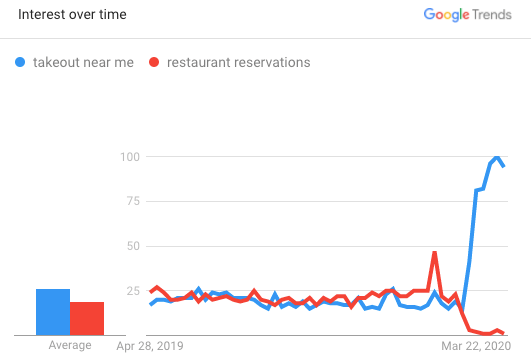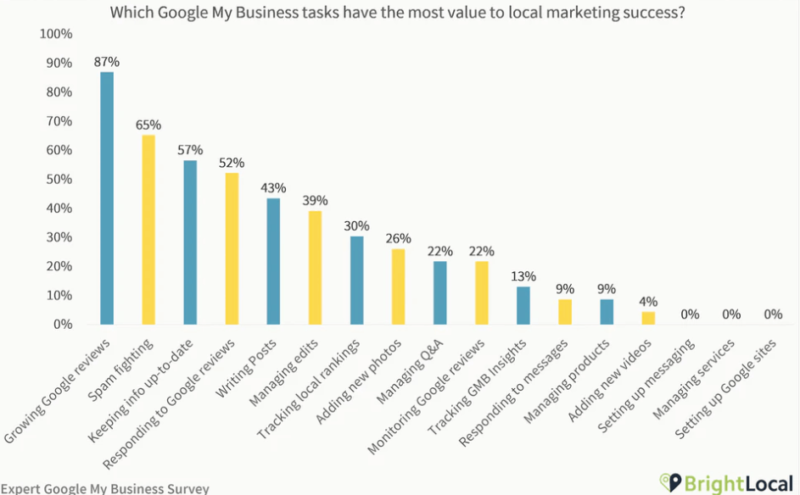GMB usage declines, but poised to become more powerful post-coronavirus
Google, and the pandemic, have made GMB into the most important local marketing tool for SMBs and multi-location brands.
Google My Business (GMB) is a core focus for local SEOs. It has also become the central locus of communication between businesses and consumers about store hours, closures, services and other information during the COVID-19 outbreak.
Shifting engagement on GMB. Click and call data show that consumer engagement with GMB has changed significantly during the crisis, as people have shifted their buying behavior online and, although it varies considerably by category, away from physical business locations.
As one example, the query “takeout near me” has spiked beyond “restaurant reservations” since shelter-in-place orders took effect. This remains a local query; what’s changed is the transaction (now, mostly online) and its fulfillment (pick-up/delivery).
‘Takeout near me’ vs. ‘restaurant reservations’

Directions, clicks, calls and reviews. Driving directions requests, as you might expect, have fallen off dramatically, but calls and website visits, driven by GMB, have not been impacted as much. New data from Reputation.com argues that “GMB driving-direction clicks are down 60% across all verticals.” Website clicks have decreased 31% and call clicks are down 21%. Other data I’ve seen show somewhat different numbers, but it’s safe to say that clicks have migrated away from driving directions to website visits and calls.
In terms of GMB actions, Reputation.com also reports significant declines for retail, restaurants and automotive, but, more recently, there has been a modest recovery in consumer engagement. This may mirror an uptick in online shopping and e-commerce spending driven in part by stimulus checks and by a sense that we may be coming to the end of the lockdown period.
GMB Clicks Breakdown: Directions, Calls, Websites

Reviews are something of a blind spot, given that Google had stopped publishing new reviews and business owner replies until recently. Now that reviews have come out of quarantine and are trickling back in, it will be interesting to see whether and how review patterns changed during the lockdown period.
Post-pandemic, GMB will continue to be a local business lifeline. As businesses reopen, local marketers will once again turn to GMB to communicate about operating hours, products and service availability. And, it will likely emerge from COVID-19 an even more important marketing tool than it was before the pandemic. Local features such as Posts, which enabled businesses to more easily communicate timely updates with their customers, may gain wider adoption and new prominence. And, Google may accelerate the rollout of other tools in the pipeline.

Sixty-eight percent of local marketing experts said GMB was more important now than it was a year ago, according to a survey by BrightLocal. Moz’s most recent Local Ranking Factors study concluded GMB signals were the top-ranking factor for the Google Local Pack and number four for local SEO. Among the many tasks to manage and monitor on GMB, growing reviews was considered by 87% in the BrightLocal survey to be the most important to local marketing success.
Fighting spam (such as fake listings and illegitimate reviews) on Google was number two. Indeed, Google has a significant fake reviews problem that the company urgently needs to address in a sustained and vigorous way.
Why we care. The next 12 months will likely see an acceleration of GMB’s evolution. Local search has always been about using digital tools and information to make purchase decisions offline. Over the long sweep of GMB’s evolution, it has grown from being a way to get content to Google into a dynamic channel mediating transactions between consumers and business owners.
Post-COVID, we’re going to see a much tighter integration of digital tools (inventory, booking, ordering, payments) with offline fulfillment, further blurring the distinction between online and offline — reflected in Google’s acquisitions of TheOrdering.app and Pointy. These are examples of how Google is trying to bridge the digital-physical divide and how it continues to make itself indispensable, not just as a marketing channel, but increasingly as a kind of back-office platform for local business.
Contributing authors are invited to create content for Search Engine Land and are chosen for their expertise and contribution to the search community. Our contributors work under the oversight of the editorial staff and contributions are checked for quality and relevance to our readers. The opinions they express are their own.
Related stories
New on Search Engine Land